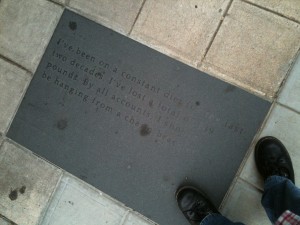Red Bull to the rescue
ASP.Net Popup window from a hyperlink within Gridview results that passes 2 parameters

I spent a fair amount of time nailing this one down so I figured I’d better record it for future reference.
From within your gridview section add your columns and change one of the columns to a template then you can manipulate what shows up for that column.
<asp:HyperLink ID=”HyperLink1″ runat=”server” Font-Underline=”True”
NavigateUrl=<%# String.Format(“javascript:void(window.open(‘http://intranet/somepage.aspx?parameter1=” & Eval(“gridviewColumnName1”) & “¶meter2=” & Eval(“gridviewColumnName2”) &
“‘,’_blank’,’width=750,height=700,toolbar=no,status=yes,scrollbars=yes,resizable=no’))”, Eval(“gridviewColumnName1”)) %>
Text='<%# Bind(“gridviewColumnName1”) %>’></asp:HyperLink>
What you end up with is a hyperlink that looks something like this:
javascript:void(window.open(‘http://intranet/somepage.aspx?parameter1=gridviewresults1¶meter2=gridviewresults2′,’_blank’,’width=750,height=700,toolbar=no,status=yes,scrollbars=yes,resizable=no’))
So the hyperlink will popup a window and take you to your specified page and passes 2 parameters to the page that can then be acted upon.
Hopefully this makes sense. It does to me right now, but who knows when I come back to it later! :)
Note: many times when you copy and paste this sort of code into your environment you’ll have to change the apostrophes because they get replaced with a backwards apostrophe which will cause problems.
Find Columns in a table in SQL Server 2005/2008

I couldn’t find an easy way to search for a column across all tables in SQL Server 2008 like I could in 2003.
After some poking around on the internet I found the following on this blog:
Select O.name objectName, C.name ColumnName
from sys.columns C inner join sys.objects O ON C.object_id=O.object_id
where C.name like ‘%NameOfColumnHere%’ order by O.name,C.name
Note: Sometimes when you copy and paste the apostrophes get changed surrounding the name of the column you are looking for so you might need to delete them and put them back in.
Update:
The following is for finding stored procedures:
SELECT ROUTINE_NAME, ROUTINE_DEFINITION
FROM INFORMATION_SCHEMA.ROUTINES
WHERE ROUTINE_DEFINITION LIKE ‘%NameOfStoredProcedureHere%’
AND ROUTINE_TYPE=’procedure’
Long neck
Waiting for pizza
Walking alone
Greenville
Greenville, SC
Brandon waiting to board our flight.
Jelly Fish
Chillin
Youth pie auction night
The kids singing in Church
Terri’s cousin’s wedding
Outside wedding
Want an apple?
Walking by Michigan Lake
Miscellaneous power settings for OSX on x86

sudo pmset hibernatemode 0
Reboot then:
sudo rm /var/vm/sleepimage
sudo pmset lidwake 0
Check power settings:
sudo pmset -g
Bios settings:
Enabled EDB. Disabled Legacy USB Support. Enabled USB S3 Wake-Up
Brightness Mode Control – User Control


























